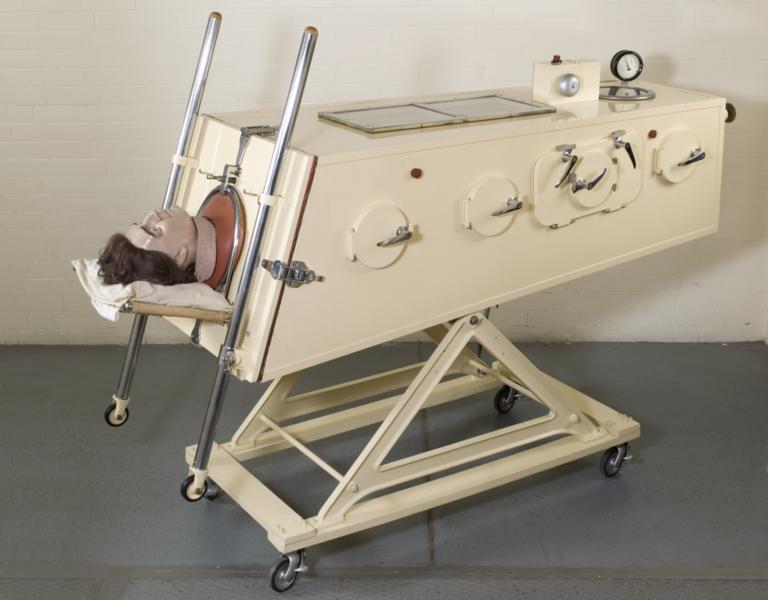
South Australian Medical Heritage Society Inc
Website for the Virtual Museum
Home
Coming meetings
Past meetings
About the Society
Main Galleries
Medicine
Surgery
Anaesthesia
X-rays
Hospitals,other organisations
Individuals of note
Small Galleries
Ethnic medicine
- Aboriginal
- Chinese
- Mediterran
In the Museum Store at Netley there is one of the early “Iron Lungs” designed and developed by an Adelaide man, Edward Thomas Both. His workshop, since demolished, was situated on the end of the western wing of the old Armoury and Mounted Police Barracks behind the museum. There was an extra room on both the lower and upper stories, next to where the Children’s Library used to be. This was where Ted Both and his brother Don established their firm “Both Laboratories".
Two years before World War II there was a severe outbreak of Poliomyelitis in Adelaide and the Both brothers were asked by the SA Health Department to develop an “Iron Lung”. He soon produced the “Both Cabinet Respirator” in his room behind the Museum. There had been an earlier American version, but the Adelaide design was much simpler and cheaper to manufacture. During the summer of 1937-38, such was the demand for the “Iron lung”, that within an hour of each one being completed it was being used by a patient. Both’s design soon won world acclaim.

Both cabinet respirator
The following year there was a polio epidemic in London and Both moved there to work on new patterns for the respirator. The industrialist Viscount Nuffield announced that he would subsidise, to the extent of £500,000, the supply of “Both” respirators to all parts of Britain and the British Empire . His Morris motor works were soon producing them by the thousand, at one-thirteenth the cost of the American design.
When Nuffield was complimented on his generosity, he responded, “All credit must go to Both”. The London magazine Punch quipped, “We respectfully differ; All credit must go to both”. The “Iron lung” at Netley is one of these manufactured in England . It is constructed of plywood and stainless steel and rests on a wheeled frame.
Badges attached to the cabinet read:
"Both Cabinet Respirator
Presented by Viscount Nuffield
and made in UK by Nuffield Organization
to a South Australian design
(ET and DJR Both)."In 1940 Edward T. Both was awarded an OBE for his work on the “Iron Lung”.
He was a prolific inventor, earning himself the nickname of "The Edison of Australia”. As early as 1935 he had invented the world’s first portable electrocardiograph, which became standard equipment in military hospitals during World War II.
He also invented a device to record the rate of machine-gun fire, and another which instantly detected flaws in gun-barrels.
In 1940 the petrol shortages prompted him to produce the Both electric bread delivery van. It was a three-wheeler, with front wheel drive, and could turn in its own standing-room. Another of Both’s wartime inventions was never to become widely known. It was called “Visitel” - a device that used radio or wires to transmit handwriting or a drawing over any distance while it was being written or drawn. An early “Fax”, it was declared a secret project, so secret in fact that after the end of the war it was never used.
Ted Both also constructed a piece pf apparatus for the SA Museum. John Mitchell, a herpetologist, was engaged in a project investigating the movements of lizards in daylight and darkness. The lizards were kept in a finely balanced cage and exposed to varying periods of light. Both built a battery operated recording machine, with a roll of paper on a drum that was able to accurately trace the lizards’ movements.
There is another coincidental link with the SA Museum. Ted and Don Both were first cousins once removed of Otto and Joe Rau, who were taxidermists to the museum for over 40 years. They were all descendants of Johann Heinrich Both and his wife Juliane, who came to South Australia in 1838, 2 years after the founding of the colony. There are still many descendants of the family living in the Jamestown area and in Adelaide .
In 1952 Ted Both, now living in Sydney, produced the well-known “Davis Cup” scoreboards and in 1956 was responsible for the scoreboard of the Melbourne Olympic Games which contained 10,000 electric light globes.
However the greatest contributions of the Both Laboratories were in the field of medical equipment. In 1953 Don Both, who remained in Adelaide, designed the “Humidicrib” which has since saved thousands of lives. The brothers who continued to work together, also produced the first electro-encephalograph, as well as x-ray equipment, nerve stimulators, foetal heart-recorders, suction units, tomographs, defibrillators, cardioscopes and blood transfusion equipment. All the apparatus was manufactured in the Adelaide workshops of Both Equipment Limited, which relocated to Tavistock Street (now Frome Street ) and later to King William Street in Kent Town .
In all, this was an impressive set of achievements for two Adelaide boys who commenced work at the rear of the South Australian Museum.
I am indebted for much of this information to
- Paul Lawson former Exhibitions officer at the museum.
- Jim Hedge, “Australia ’s Thomas Edison. E.T.Both”, published in the ANA magazine “Air Travel”
- The Both Family History, 1750-1980 ( Adelaide, 1981).
- Nancy Robinson, “Change on Change, A History of The Northern Highlands of South Australia” (Adelaide, 1971).
- Wayne Kitchener for the photograph of an early iron lung made by Both Instruments in Kent Town.
-o0o-